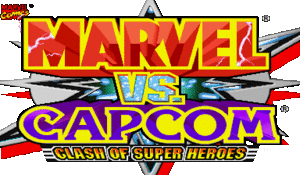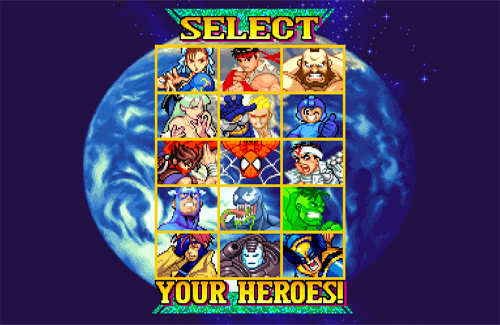| Marvel VS Capcom: Clash of Super Heroes (MVC1) | |
|---|---|
| Developers |
Capcom |
| Systems |
CP System II |
| Dreamcast JP: March 25, 1999 NA: September 30, 1999 EU: June 23, 2000 | |
| PlayStation 1 JP: November 11, 1999 NA: January 27, 2000 EU: January 31, 2000 | |
| PlayStation 3 (Origins) NA: September 25, 2012 EU: October 10, 2012 | |
| Xbox 360 (Origins) WW: September 26, 2012 | |
| Online Play |
Rollback (via MVCC) |
| Rollback (via PSN/XBLA) | |
| Rollback (via Fightcade) | |
| Rollback (via RPCN) | |
| Player Resources | |
| RedGGPO Fightcade alternative | |
| RedGGPO Discord | |
| MVC1 Japanese Wiki | |
| DC Japanese Site | |
| Japanese archive | |
| Community Channels | |
Introduction
Marvel VS Capcom: Clash of Super Heroes is a crossover, tag-team fighting game developed by Capcom, and released on January 23, 1998, developed for the CPSII Arcade board. It is the third game in the Marvel VS Capcom video game franchise, and the fifth overall Marvel fighting game developed by Capcom, serving as the sequel to Marvel Super Heroes VS Street Fighter. The game features a playable roster of 21 characters and 22 assists, split (mostly) evenly between the two companies. Much like its predecessors, and unlike the games that came after it, MVC1 features 2-VS-2 tag-team fighting gameplay, rather than the 3-VS-3 gameplay the series is well known for. In addition to this, assists are no longer teammate based, but rather based on a separate roster of characters who each have a unique function, distinguishing them from the playable roster. MVC1 also added the additional feature of Duo Team Attacks, where both player characters come out to attack for a limited period of time until their meter runs out, distinguishing it from the team supers of future Marvel games.
Marvel VS Capcom EX Edition, as it is known in Japan, is the PlayStation 1 port of the game. It is considered inferior to the arcade version for the reason that it removes the tag-team mechanic altogether. While it offers a mode under the name of "Cross Over" mode to give tag-team functionality, teams must be identical to one another in this mode, serving as a compromise to the PS1's small memory size. Therefore, the arcade version is vastly preferred over the PS1 port.
Story
The storyline is loosely based on the X-Men: Onslaught arc from the Marvel Comics continuity: following an incident in which mutant telepath Charles Xavier was forced to enter into the mind of Magneto, part of Magneto's anger slipped into Xavier's psyche, and after merging with Xavier's darkest emotions it spawned a powerful psychic entity known as Onslaught. The game expands on the story by having Xavier's conscience calling forth heroes from the Capcom universe in order to help stop him.
Why Play Marvel VS Capcom 1?
Do you want a more digestible but still challenging Marvel VS Capcom experience? Or perhaps you want an MVC experience closer to its retro roots in the arcades? Don't like what Marvel VS Capcom Infinite brings to the table? Need a break from the likes of MVC2 and UMVC3 while still getting the MVC experience? This is the game for you, then. Like Infinite, you're more likely to deal set combos and fishing for hits rather than rushing to steal the first death... Well, for the most part if you ignore Red Venom, War Machine and Wolverine. The game gives you room to breathe and play a more unique midscreen game where combos are generally finite, assists are limited in usage, and the roster is small but focused, while still providing the Marvel experience of tight gameplay and frantic chaos. What also sets this game apart from the rest of the series is that while it is not immune to infinites or touch of death combos, for some characters combos are more rigid and finite. However, death combos are usually locked behind team duo supers - the game's defining mechanic where you control both characters at the same time for a brief period. The top tiers not only have infinites and/or death combos, but they - as well as a few others - benefit from the game's most infamous glitch, the uncombo. Tricking the game into thinking a combo is over when it really isn't, uncombos reset the damage scaling mid-combo, making killing off characters more efficient. You also have other nuances like crouch cancels, random damage numbers, six secret playable characters, and in general a different physics system that's closer to what Marvel Super Heroes, X-Men vs Street Fighter, or Marvel Super Heroes vs Street Fighter provide. MVC1's tech can be harder to pick up but on a surface level, it's close enough to the rest of the series that if you've played MVC before, it's not difficult to pick up. It's simple enough at first that you can pick whatever two characters you like and as long as you focus on learning the basics first, then it's easy enough to pick up and try out. It oozes 90s aesthetic, provides arguably the best mix of Marvel characters for its time in fighting games, and shows a culmination of everything Capcom had learned up to that point. Though overshadowed by MVC2 and UMVC3, it's on Fightcade, easy to emulate, and still holds up very well to this day.
Main
| 20% complete | ||
|
|
| In Progress / Completed | To-do |
|---|---|
|
|






















